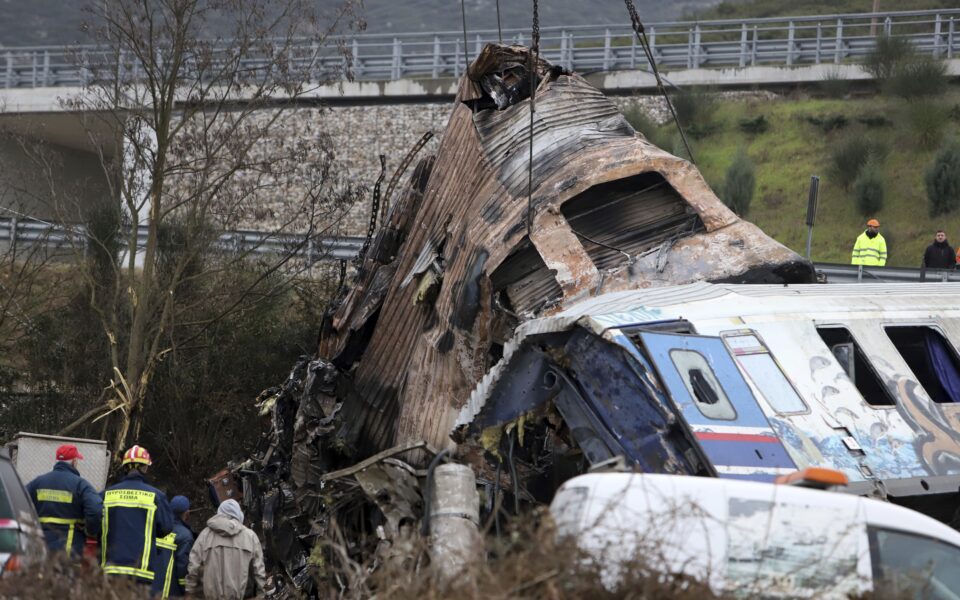Key points in the ongoing Tempe tragedy probe
A year after the railway collision that cost the lives of 57 people, the trial is getting closer and the list of suspects is getting longer

Even though a year has gone by since the February 28, 2023 rail disaster near Larissa at Tempe, central Greece – which claimed the lives of 57 people, most of them young university students returning from a long weekend break – judicial authorities appear to have widened the scope of inquiries in recent weeks, adding more names to their list of suspects.
The growing list is seen as an admission that the net of culpability needs to be cast wider, and not limited to the stationmaster at the central Larissa station who set the InterCity 62 train, northbound from Athens to Thessaloniki, on the same course as the southbound freighter, and to the former head inspector at Larissa station who had assigned him to the shift in question on that ill-fated night.
Other key factors that contributed to the tragedy include the state of the railway line and the fact that automated traffic control and safety systems that should have been operating were not, even though millions of euros had been spent on having them installed. This is supported not just by the judicial authorities in Larissa investigating the crash, but also by the European Public Prosecutor’s Office (EPPO), whose separate probe resulted in charges being brought against officials at ErgOSE – the Hellenic Railways (OSE) subsidiary responsible for railway infrastructure – at the Ministry of Transport and at the TOMI-Alstom consortium, which was responsible for implementing the notorious Contract 717 for the remote signaling and railway control projects.
The same probe found indications of breach of duty and misappropriation of funds on the part of Christos Spirtzis and Kostas Karamanlis, who served as the ministers of transport under different governments from 2016 and until the crash, and were ultimately responsible for ensuring that the contract had been implemented.
The findings of EPPO’s investigation were sent to Greece’s Parliament, though the House majority rejected the recommendation for a preliminary inquiry committee.
This January, however, the Larissa Appeals Prosecutor’s Office brought criminal charges against 15 ErgOSE officials who served as CEOs or board members from 2016 to February 28, 2023. They are accused of disrupting public transport safety and numerous misdemeanor counts of negligent homicide and causing bodily harm. According to legal circles, the charges also include the element of “possible intent,” indicating that there may have been some kind of financial motive behind the nine-year delay in implementing Contract 717.
The recent charges against the ErgOSE officials were prompted by a letter from a Larissa investigative magistrate at the Court of Appeals requesting that EPPO’s inquiry be included in the local case file. Sotiris Bakaimis argued that if Contract 717 had been implemented as it should have, the accident would not have happened.
Relatives of the Tempe crash victims have also publicly and privately condemned mistakes and oversights in the investigation, particularly with regard to the period before it was assigned to Bakaimis. They are, however, eager for the investigation to be wrapped up so that the suspects can finally face trial.
Victims’ lawsuits
“There were screams and voices everywhere, inside and outside the carriages, people begging for help, for their lives, and fires burning all over the place, together with a strange smell, which I couldn’t identify at the time except for knowing that it made my head spin and made me panic. I can now say with certainty that it was the smell of death and burnt flesh.”
Testimonies like this, from a 21-year-old survivor of the crash, form part of the lawsuits filed by survivors and victims’ relatives in the months following the tragedy. They have also been included in Bakaimis’ hefty case file.
Like others, the 21-year-old’s lawsuit is against the jailed stationmaster, the managements of ErgOSE and Hellenic Train, the railway’s operator, as well as against all “other parties involved.” He and another four university students on the ill-fated InterCity 62 claim that they sustained injuries and burns that caused them pain for months after the crash, as well as sleep disorders, headaches and other symptoms consistent with serious post-traumatic stress disorder.
“We saw chaos, passengers covered in blood, dismembered bodies and flames everywhere; scenes of complete horror that we will never get over. I have been under psychiatric observation and on medication for three months,” a postgraduate student who was traveling back to university in Thessaloniki said in a report dated May 24, 2023.
In early August, several victims and relatives filed suit against the management of OSE, ErgOSE and Hellenic Train, as well as against the two former transport ministers for the “mass crime at Tempe,” following publication of the findings of the European Prosecutor’s Office. The question of the delay in implementing Contract 717 has resulted in an extensive blame game between the different officials involved.
Another flurry of lawsuits came in late August against “unknown perpetrators” for “tampering” with the scene of the accident. These suits referred specifically to the fact that the crashed carriages were removed from the site and it, in turn, was covered in gravel and asphalt, before the forensic examination could be concluded, and specifically before the Larissa Chemical Laboratory could investigate the site. The former regional governor of Thessaly, who was responsible for this decision, was named in the suits in early February this year.
The flammable substance
Just six-tenths of a second after the two trains collided head-on there was a massive explosion and the first two carriages of the InterCity 62 burst into flames. Of the 57 people who died in the crash, 30 were completely burned, though an exact cause of death has not been determined. Technical experts commissioned by victims’ relatives to investigate argue that the blast was caused by some kind of flammable material, which has yet to be determined.
In a document addressed to the special investigative magistrate in the summer of 2023, Hellenic Train claimed that the explosion was the result of a combination of sparks from electricity cables that were severed on impact and the presence of silicone oil, which is used as an engine cooler. The Fire Service came to the same conclusion during its investigation, which was commissioned by Bakaimis. It found traces of this substance in samples taken from all over the crash site and even as far as 50 meters away from it. Two independent experts commissioned by the investigative magistrate concurred.
The families’ technical advisers, however, responded with a series of experiments in which they claim to have found that silicone oil is not at all flammable. In their report, therefore, they suggested that there might have been another substance involved that exacerbated the consequences of the impact. Their suspicions were heightened by the fact that samples taken from the crash site just a few weeks after the collision and analyzed by the State Chemical Laboratory revealed traces of xylol, a highly flammable solvent used in paint but also found in the illegal trade of adulterated fuel. The substance was found even though the crash site had been covered up.
In his recent testimony to Parliament’s inquiry committee, the Italian CEO of Hellenic Train, Maurizio Capotorto, claimed that xylol is used to clean graffiti off the rail carriages. His claims did not convince the privately hired experts, who have been looking into what the freight train was carrying. Responding to a similar question concerning the cargo posed by Bakaimis, Hellenic Train has said it was carrying sheets of metal, metal wiring, beer and foodstuffs.
In the meantime, the videos from the security cameras at the Thessaloniki station where part of the cargo was loaded onto the freight train have been deleted – the tapes are wiped automatically and reused – raising questions about whether the train may have been carrying other substances as well. In a memo addressed to the Supreme Court prosecutor in August, in fact, a group of victims’ relatives questioned whether the train may have been carrying illegal cargo.
Legal sources have told Kathimerini that the specific matter of the explosion may be separated from the rest of the case file so that a more comprehensive investigation may be carried out, without delaying the trial further.





